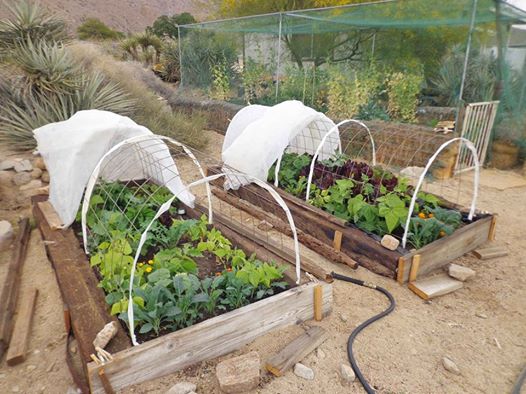A changing climate challenges every gardener to rethink the way we grow vegetable gardens. Everywhere the extremes of the growing season are hotter, colder, wetter, drier, and nature is responding in ways we never anticipated. Bugs don’t die and their eggs or pupae live into a second year to infest plants. Abnormal cold late in spring or early in fall shorten the growing seasons so some crops can’t mature fully. Drought stresses plants so much their normal resistance to heat, pests and disease is diminished. Only one thing is for sure: unpredictability is the new normal.
Organic market gardeners who can’t afford to lose their crops drove development of problem solving fabrics called row-covers. These materials allow rain and air to pass through, but keep everything else out. They sit upon hoops over vegetable rows to create temporary Quonset hut-shaped affordable greenhouses that both protect the plants and enhance their yields.
The basic row cover set-up is about four feet wide and is of infinite length. It’s composed of support hoops made of wire, PVC plastic or metal grids sold for reinforcing concrete. Row cover fabric is laid over the tops of the hoops, the long sides anchored to the ground with rocks or earth or a long piece of salvaged lumber. The ends are gathered like a pony tail, tied closed and secured with a stake. Inside this Quonset hut the plants are protected from weather and pests and cold. When they grow older and less vulnerable or too large, row covers may be partly or completely removed to allow pollinators to reach the flowers. The same or different covers can be replaced at any time of the season depending on the crop’s unique needs, or to solve both expected and unexpected challenges.
Row cover fabrics vary in purpose and weight. The most valuable to home gardeners is the super lightweight “floating” row covers made of spun polypropylene designed to keep seedlings protected from insect pests. Preventing the start of these problem bugs early in the season using a row cover shelter allows plants to thrive and grow more quickly to a size better able to protect itself naturally.
Row cover material increases in weight and density with each increment of frost protection. Using row covers to plant earlier in spring reduces the amount of time you must tend small seedlings indoors. The row cover can be removed after temperatures warm, or you can replace it with the light weight floating covers for insect protection. During the depths of summer a row cover can provide ideal shading in very hot southern regions. Then in the fall as temperatures fall, frost-preventing row covers go back on the garden to keep plants productive long after the rest of the garden is lost. In mild climate regions row covers can mean fresh produce throughout the winter months.
Row covers also help to maintain humidity around plants and to reduce evaporation of moisture from the soil. This is a big help for areas where drought has limited water availability. These covers can not only improve the effectiveness of drip irrigation, plants are less likely to become desiccated in hot windy weather.
Arbone is the most common brand of row cover sold by most seed catalogs as well as organic gardening and farming supply houses. At GrowOrganic.com there are videos and helpful articles on using row covers in the residential garden. They sell a full line of covers and accessories to make this year’s garden the best ever.
If you’re not having the success you dreamed of, or if a brutal winter delayed your start, try a new solution. Once you discover how well the pest netting works and how easily covers are to set up, you’ll never go back. When climate change makes the going tough, the tough get growing…with row covers.
Row covers are the desert gardener’s secret weapon for growing in a harsh climate with minimal water.


